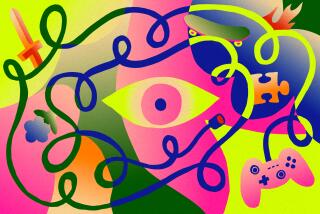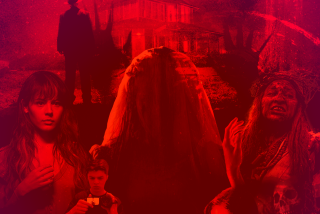Review: ‘Little Nightmares 2,’ a horror fairy tale game even this scaredy-cat finds beautiful
I jumped more than a few times while playing “Little Nightmares 2,” frightened by a sudden movement or the scurrying of something in the dark. I even had to set the controller down once or twice when my nervous hands made it impossible to properly maneuver the slow-moving child protagonist at the heart of the game. And then there were moments I turned on all the lights in my apartment, as if surrounding myself in brightness would make it easier to play.
But I mainly want to talk about what I thought were moments of pure beauty and thoughtfulness.
“Little Nightmares 2” is a horror game for people who don’t necessarily think they like horror games. That includes me. Of course, the game’s appeal stretches beyond that demographic slice (the first game in the series has sold more than 2 million copies). “Little Nightmares 2,” like the original, feels rooted in fairy tales rather than gore, violence, grotesqueness or pure jump scares and stealth, tapping into the mix of fear, apprehension and curiousness we feel as children and carry with us into adulthood.
It’s not a fear of evil, per se, but apprehension about the unknown and what lies ahead.
This is a game that asks us to linger in its creaky, downtrodden locales, to focus on details rather than grand unspeakable terrors. It’s frightening and alluring because, as we run and jump amid this mostly side-scrolling platformer, the primary emotion the game evokes is one of anxiety. It recalls the look and tone of foundational storybooks, not to mention horror-movie tropes such as static-filled televisions, but brings just enough touches of recognizable modernity to make it familiar and yet also uncomfortable.
We’re not quite alone throughout “Little Nightmares 2.”
While it’s definitely not a requirement to have played the first one to enjoy the sequel — the game traffics in frighteningly fantastical imagery and metaphors rather than plot — we are joined through most of our journey by Six, the yellow-raincoat-sporting little girl from the first game. Six is there to help us solve puzzles, but I found that much of the enchanting nature of this scary game relied on the way Six felt less like an artificially intelligent companion and more like an actual collaborator.
As someone who simply does not like to feel overly tense when consuming media, it was the relationship between the player-controlled protagonist — his name is Mono and he wears a paper bag over his head — and Six that kept bringing me back. I smiled in pure delight when one early simple puzzle required Mono and Six to jump in time, signaled to the player by Six trying to get us in rhythm. Or, later, when Mono finds a flashlight, the way Six waves him away when the light catches her eyes.
This connection between Six and Mono feels like the crowning achievement of “Little Nightmares 2.” There are times when entering a room Six will run toward an object, leap into an elevator or crawl along a wall above a creepy pianist. She’s not so much giving us a solution but showing us there’s a way forward. This creates a bond, but also telegraphs early to the player that we must move into this foreboding world with conviction rather than tentativeness.
Extra lives. Deaths. They’ve long been part of games. But in our COVID-19 year, the games that resonated asked us to rethink how we view the end of of lives.
In a game where some commands can be approached with skepticism — when we don’t want to know what’s in the shadows, it sounds like a dare when we’re told to press a button to turn on a flashlight — I often felt a sense of hope through Six. In one scene, Six and Mono hop and climb among beds that seem to be floating in air. I set down the controller to just admire the sense of wonder the art conveyed.
Sure, these were used, filthy and broken hospital beds we were traversing, but in these playful moments “Little Nightmares 2” approached the macabre with the kind of surprise present in Tim Burton’s early work. What Sweden’s Tarsier Studios has developed feels like the video game equivalent of something that could have been bound in a volume of “Grimms’ Fairy Tales.” It’s not fun when a loose hand turns into a face-sucking creature, but the game is also about showing us that the places we fear and the grown-ups we mistrust aren’t all that frightening if we use our minds to the best of their puzzle-solving ability.
We start with simple locations familiar to all horror fans — a forest, a creepy cabin — but soon enter a school, a place of early consternation for many of us. This is where “Little Nightmares 2” fully takes flight; fragile, bullying children aren’t what they seem and teachers have a way of seeing around corners.
The schoolyard horrors of “Little Nightmares 2” don’t allude to present-day realities such as our current pandemic or the now ever-present fear of gun violence. Yet it’s hard not to to think of such unsettling realities as we crouch in corners, hide in boxes and rush to avoid tight spaces with other children, who want to shout, throw food and fart, but also want to tie us up by our feet and string us from the bathroom ceiling.
“Little Nightmares 2” turns a place of safety into one of pure antagonism, from both its environment and inhabitants. Images of innocence — children — snap and shatter as if they are Precious Moments dolls gone rotten, whereas our elders have snake-like necks and moldable faces that reminded me of the exaggeration of Garbage Pail Kids cards. When a teacher stands in place as her neck careens up and down Victorian bookshelves, they look less like humans and more creations made of clay. But I didn’t see a monster so much as a symbol, a never-ending sense of dread toward any authority figure whom we perceive as having more control than us.
In turn, the game makes us, the player, feel helpless. And the ability to regain a sense of composure, to master each room, each puzzle, hooked me. I honestly didn’t expected it to, as I’m a complete scaredy-cat — I have never been able to handle any “Resident Evil” game.
But “Little Nightmares 2” is so fully fleshed out in its details that it encourages not just a patient approach but manages to obscure the most obvious solution, to make you feel stumped when confronted with levers, incinerators or X-ray machines. Sometimes all these items work together; sometimes they’re diversions that stop you from seeing a button right in front of you.
Oh, it’ll shock you when a headless figure leans forward and dismembers your character, but the way to best almost every puzzle or challenge is to stop, take in a room and learn how your surroundings can be maneuvered. While there’s some combat, the mere holding of a weapon is a burden for our tiny, frail child, and thus, “Little Nightmares 2” was never teaching me how to win or “best” a foe as in a standard video game battle.
Solutions sometimes were as simple as, say, trusting myself to walk Mono backward. Or, other times, figuring out that in this world brains are meant to be tossed like rubber balls, a realization that hit me after spending hours climbing up and down shelves to the point that the gooey brain on the floor was no longer a gross thing I was trying to avoid but maybe a tool.
I felt silly for not seeing the solution earlier, but that’s how “Little Nightmares 2” gets under your skin and sneakily reveals its own fairy tale messages. The world is designed to confuse, confound and frighten us, and letting it do so will not just destroy our sense of curiosity but our confidence. At least that was the lesson I took from being scared of the brain on the floor, which for an evening brought my in-game world to a halt until I understood that the thing I feared was actually the key to my escape.
Little Nightmares 2
More to Read
The biggest entertainment stories
Get our big stories about Hollywood, film, television, music, arts, culture and more right in your inbox as soon as they publish.
You may occasionally receive promotional content from the Los Angeles Times.











